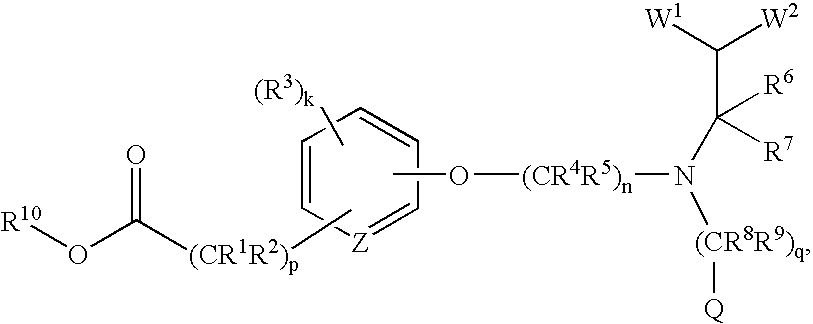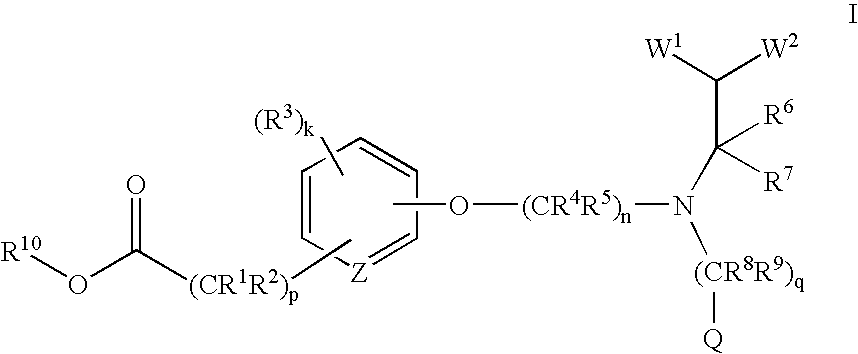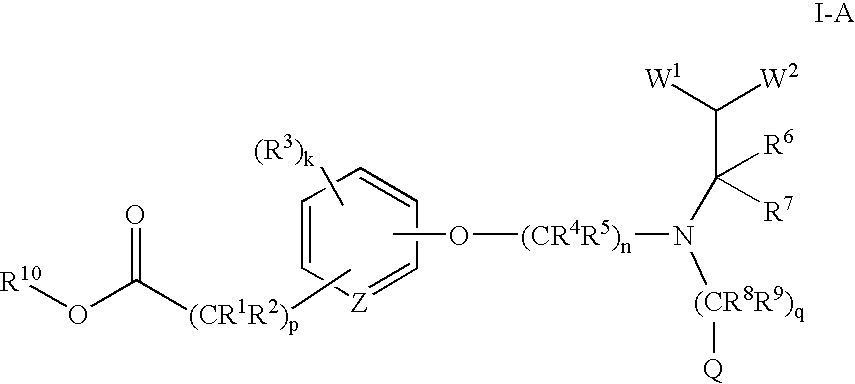Acid and ester compounds and methods of using the same
a technology of ester compounds and acids, applied in the field of compounds, can solve the problems of high risk of cardiovascular disease, incomplete absence or low levels of hdl cholesterol, etc., and achieve the effects of reducing inflammation, increasing reverse cholesterol transport, and inhibiting cholesterol absorption
- Summary
- Abstract
- Description
- Claims
- Application Information
AI Technical Summary
Benefits of technology
Problems solved by technology
Method used
Image
Examples
example 1
(R)-2-(3-{3-[[2-Chloro-3-(trifluoromethyl)benzyl](2,2-diphenylethyl)amino]-2-methyl-propoxy}-phenyl)acetic acid methyl ester
[0262]
a) (3-Hydroxy-phenyl)-acetic acid methyl ester
[0263] To a stirring solution of (3-hydroxy-phenyl)-acetic acid (4.3 g, 0.028 mole) in methanol (30 mL) was added H2SO4 (1 mL) and the mixture was heated to reflux for 2 hours. The solvent was removed, the residue was washed with H2O, and extracted three times with EtOAc (ethyl acetate). The combined organic layers were dried over Na2SO4, filtered, and concentrated to give 4.7 g (99% yield) of the title compound as an oil. MS (ESI) 167.0 (M+H+).
b) (S)-[3-(2-Methyl-3-bromopropoxy)phenyl]acetic acid methyl ester
[0264] To a stirring solution of (3-hydroxy-phenyl)-acetic acid methyl ester (0.75 g, 0.0045 mole) in anhydrous toluene (30 mL) was added (S)-(+)-3-bromo-2-methyl-1-propanol (0.90 g, 0.0059 mole). Polymer bound triphenylphosphine (2.4 g, 0.0072 mole, 3 mmol / g, Fluka Chemie) was then added, and the mix...
example 2
(R)-2-(3-{3-[[2-Chloro-3-(trifluoromethyl)benzyl](2,2-diphenylethyl)amino]-2-methyl-propoxy}-phenyl)acetic acid hydrochloride salt
[0267]
[0268] To a stirring solution of (R)-2-(3-{3-[[2-chloro-3-(trifluoromethyl)benzyl](2,2-diphenylethyl)amino]-2-methyl-propoxy}-phenyl)acetic acid methyl ester (22 mg, 0.0361 mmol) in THF (0.75 ml) and water (0.25 ml) was treated with LiOH (3.0 mg, 0.072 mmol). The reaction mixture was stirred overnight at RT. The reaction mixture was concentrated and 3 N HCl (aq.) was added until the pH was less than two. The aqueous layer was extracted three times with EtOAc, the combined organic layers were dried over sodium sulfate, filtered, and concentrated. The resulting amine / carboxylic acid was dissolved in Et2O (diethylether) and acidified with 1.0 M HCl / Et2O. The reaction mixture was concentrated in vacuo and dried under reduced pressure to give 18 mg (78% yield) of the title compound as a white solid. MS(ESI) 596.0 (M+).
example 3
(S)-2-(3-{3-[[2-Chloro-3-(trifluoromethyl)benzyl](2,2-diphenylethyl)amino]-2-methyl-propoxy}-phenyl)acetic acid hydrochloride salt
[0269]
[0270] Following the procedure of Example 1 and 2 except (R)-(−)-3-bromo-2-methyl-1-propanol was used in step 1(b) instead of (S)-(+)-3-bromo-2-methyl-1-propanol, the title compound was isolated to give 37 mg (12%) of a white solid. MS(ESI) 596.0 (M+).
PUM
 Login to View More
Login to View More Abstract
Description
Claims
Application Information
 Login to View More
Login to View More - R&D
- Intellectual Property
- Life Sciences
- Materials
- Tech Scout
- Unparalleled Data Quality
- Higher Quality Content
- 60% Fewer Hallucinations
Browse by: Latest US Patents, China's latest patents, Technical Efficacy Thesaurus, Application Domain, Technology Topic, Popular Technical Reports.
© 2025 PatSnap. All rights reserved.Legal|Privacy policy|Modern Slavery Act Transparency Statement|Sitemap|About US| Contact US: help@patsnap.com



